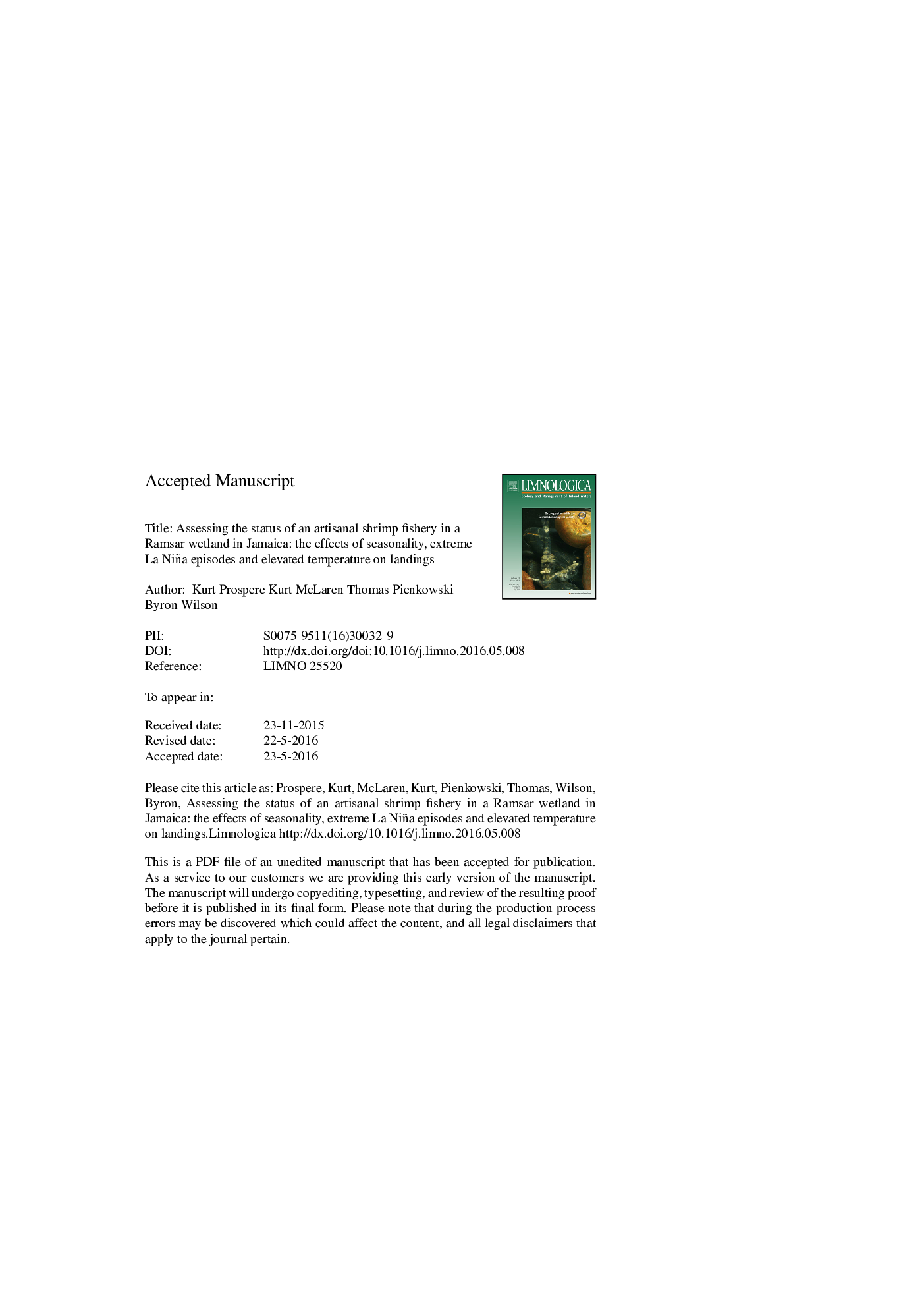| کد مقاله | کد نشریه | سال انتشار | مقاله انگلیسی | نسخه تمام متن |
|---|---|---|---|---|
| 6305527 | 1618563 | 2016 | 53 صفحه PDF | دانلود رایگان |
عنوان انگلیسی مقاله ISI
Assessing the status of an artisanal shrimp fishery in a Ramsar wetland in Jamaica: The effects of seasonality, extreme La Niña episodes and elevated temperature on landings
دانلود مقاله + سفارش ترجمه
دانلود مقاله ISI انگلیسی
رایگان برای ایرانیان
کلمات کلیدی
موضوعات مرتبط
علوم زیستی و بیوفناوری
علوم کشاورزی و بیولوژیک
علوم آبزیان
پیش نمایش صفحه اول مقاله

چکیده انگلیسی
An invasive crayfish, Cherax quadricarinatus, and several native shrimp species (Macrobrachium acanthurus, Macrobrachium faustinum, Macrobrachium carcinus, Xiphocaris elongata, and Atyidae sp.) found in the Black River Lower Morass (BRLM), a Ramsar Wetland in Jamaica, support subsistence and artisanal fisheries. Management of this fishery requires information on factors that influence their abundance. Consequently, we assessed the effects of seasonality, extreme and double La Niña episodes (in 2011) and elevated atmospheric temperature (in 2011 and 2012) on weekly Decapoda landing data, collected over a period of two years (2010-2012). The catch of native species showed a cyclical trend every 6 months, coinciding with the dry and wet seasons. The invasive crayfish landing showed a reverse trend during the first year, after which no pattern could be discerned. A dynamic factor analysis (DFA) model with two common trends and four explanatory variables (conductivity, mean weekly number of traps hauled, weekly mean water level, and mean dissolved oxygen) was the optimal model to characterize the variation in wet-weight landings. A generalized additive mixed model with an auto-regressive moving average (ARMA) error structure was used to show that the extreme and double La Niñas were associated with lower monthly atmospheric temperature. Sea surface temperature anomaly in region 3 (a proxy to ENSO) and the trend in temperature were then used to predict the wet weight of native shrimp (U-shaped relationship) and the invasive crayfish (reverse-j shaped relationship), respectively. The native shrimp (mean sustainable yield, MSY = 3469 kg and mean catch per fisher = 2.67 kg) and invasive crayfish (MSY = 11 kg and mean catch per fisher = 0.67 kg) are under fished, although populations of the native shrimp are possibly declining, whereas that of the invasive crayfish may be growing. The declining trend may have adverse implications for the stock of the native shrimp species, which has a higher economic value, if fishing pressure is not reduced/restricted or increased on the invasive crayfish, especially during seasonal and/or ENSO related declines in native shrimp stocks.
ناشر
Database: Elsevier - ScienceDirect (ساینس دایرکت)
Journal: Limnologica - Volume 59, July 2016, Pages 140-154
Journal: Limnologica - Volume 59, July 2016, Pages 140-154
نویسندگان
Kurt Prospere, Kurt McLaren, Thomas Pienkowski, Byron Wilson,